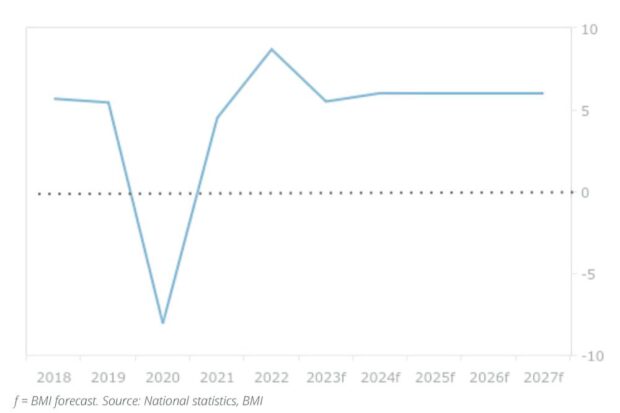PH households likely to spend more

RECOVERING PH total household spending (real) percent year-on-year 2018 to 2027. —Source: BMI forecast, Philippine Statistics Authority
MANILA -Household spending in the Philippines is expected to grow by “a strong 5.5 percent ” in 2023, thanks to easing inflation, according to BMI Country Risk & Industry Research.
However, the Fitch group subsidiary also said that if inflation remained relatively high compared with the government’s target range of 2 percent to 4 percent, household spending power may be undermined.
The research firm noted that consumer confidence has increased since its all-time low reported in the second quarter of 2020 and is showing recovery. Meanwhile, unemployment has fallen to a record low but the cost of living remained high.
“We predict inflation to remain elevated over 2023, a risk to household purchasing power in the short term,” BMI said.
The monthly readout for overall inflation has been slowing down continuously from 8.7 percent in January to 4.7 percent in July.
Article continues after this advertisementBMI said that while the latest readout was the lowest since May 2022, “it is still one of the highest levels of inflationary spikes since the global financial crisis in 2008 as prices for household goods, clothing and non-essential spending categories have remained unchanged or have accelerated.”
Article continues after this advertisementThus, high inflation is seen continuing to be a risk to BMI’s consumer spending forecast, especially if this situation prevails longer than anticipated, which will accelerate the erosion of household purchasing power.
Still, BMI shared a positive outlook for consumer spending in the Philippines over the rest of this year, considering that a wider economic recovery feeds strong real consumer spending growth.
Based on 2010 prices, BMI estimated that household spending would reach P12 trillion in 2023, improving from P10.9 trillion in 2019 before the pandemic.
“Real household spending over 2024 will grow 6 percent over 2024, to a total of P12.7 trillion,” the company added..
The Marcos administration’s economic team partly attributed to dampened consumption the 4.3-percent growth of gross domestic product (GDP) in the second quarter, which was slower than the market’s consensus forecast of 6 percent.
Still, the economic managers insist that the full-year target of at least a 6-percent GDP growth would still be achievable. INQ